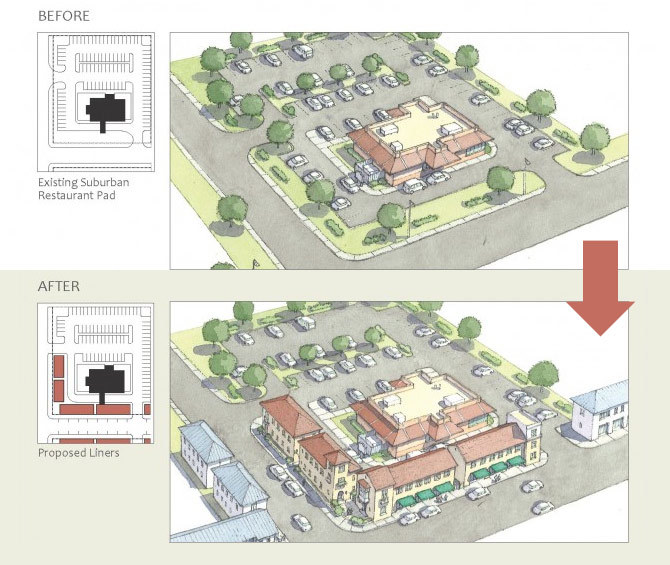Landscape Architecture for Landscape Architects › Forums › SUSTAINABILITY & DESIGN › Different Take on Planning/Smart Growth
- This topic has 1 reply, 13 voices, and was last updated 13 years, 10 months ago by
 Trace One.
Trace One.
-
AuthorPosts
-
June 10, 2010 at 2:42 am #169226
 Jason T. RadiceParticipant
Jason T. RadiceParticipantProlific writer, UPENN professor, and all around brilliant guy Witold Rybczynski has written an interesting article for Slate.com on Centralized City planning with regards to massive projects and public distrust, and smart growth redevelopment…
http://www.slate.com/id/2249253/
Add in an interview from Urbanite Baltimore…with hints of his new book Makeshift Metropolis…he goes into depth about a more rational apporach to urban challenges and planning approaches for the future.
http://www.urbanitebaltimore.com/sub.cfm?sectionID=4&articleID=1540&IssueID=85
Some of you may know that Witold Rybczynski, and architect, wrote the definitive book about the life of the original Landscape Architect, Frederick Law Olmstead entitles A Clearing in the Distance
June 10, 2010 at 11:05 am #169267 Trace OneParticipant
Trace OneParticipantMan, I wish I had his job. He takes one position, and then completely contradicts himself by the end of the interview – end result – what has he said? Nothing, but it would fill a class room hour..Good grief..And “urban parks were old-fashioned from 1900 to 1980” – what? Really?
He always pisses me off anyway – why doesn’t an LA have this job, not an architect? ASLA magazine likes to hire people who are editors, not LA’s.. stupid. At least some of these blogs are good, and giving room for more LA writing.Witolds attention getter in these posted pieces – saying that markets must drive development, seems simultaneously old hat, and contradicted by everything that is happening today..Markets with gov. subsidies gave us the expanding suburbs, and the free market has failed us so hideously in the stock market, our mining industry, the oil spill – it is all part of the ‘less government’ mantra of the past thirty years..I have spent many a summer day at Jones Beach – it is great, and would not exist without planning on the large scale.
But then, in the end of the interview, Witold contradicts himself, saying, government has a place..So what is the big deal? what did he actually say?June 10, 2010 at 6:59 pm #169266 Roland BeinertParticipant
Roland BeinertParticipant“The important lesson is not that city planning is unimportant but, rather, that urban development should not be implemented by the public sector alone and that in a democracy, a vision of the future city will best emerge from the marketplace.”
So, in a democracy, powerful businessmen should be the main people who shape our cities? I see his point about huge sweeping redevelopment projects destroying good urban neighborhoods. But I think his solution doesn’t get at the heart of the problem. Developers have always, always, always had a say in development. The heart of the problem is a disconnect between the people who live in cities and the people who have the power to shape cities (both city officials and big businesses). The average person has little say in what happens. When they are offered the opportunity to have a say, they often do not have the knowledge they need to articulate what they want, because planning theory has changed so fast. When they do successfully articulate wha they want they tend to be ignored.
As Trace pointed out, developers have been just as reponsible for bad development descisions as government. The free market is only one small part of a successful democracy. The example in the article is more plutocracy in action than democracy in action.June 10, 2010 at 8:51 pm #169265 ncaParticipant
ncaParticipantGood Topic, I featured this for more traffic, hopefully.
June 18, 2010 at 1:28 am #169264 KirstenParticipant
KirstenParticipantMixed Use seems to be an expect part of smart growth, infill and retrofits. Its is a concept that people talk about but no one really explains it and the general public don’t seem to get it or like it. Who wants to live really close to lots of neighbours, some with screeming children, others with businesses, and a constant stream of customers day or night or light industrial activity with the smell of paint, sawdust and drills. As a student it bugs me that I’m expected to understand such concepts without having been taught the reasons behind it, then hold a particular agreeable opinion on it and then design them into projects.
mutter mutter grumble grumble
June 18, 2010 at 6:23 am #169263 ncaParticipant
ncaParticipanti think the generic term ‘smart growth’ tends to take on more specific and often misconstrued meaning for different people. In my interpretation Smart Growth is non-prescriptive, but conscious of context and character with particular regard to the current market/end user.
I think a lot of people tend to attribute smart growth to high density, which I don’t necessarily think it needs to be. True smart growth in my opinion is about efficient utilization and conservation of resources, nothing more really. Take Duany’s New Urbanism for example (not just the neighborhood planning priincipals, but also the architecture, streetscape and public space specificity), though and you could certainly make an argument for prescriptive planning.
To that end, I’m not a committed believer in the ‘free market’ as a gage for demand of a particular product in the case of urban planning. I think people are smart, but it’s been shown, even exemplified in this discussion that certain principals of smart planning are grossly misunderstood on both sides.
June 18, 2010 at 7:03 am #169262 Jason T. RadiceParticipant
Jason T. RadiceParticipantI’ve worked on a bunch of ‘new urbanist’ developments like this. Mixed use primarily refers to residential over retail or office. The idea is to recreate the old downtowns where SRO’s and apartments would be above businesses. Today, its condos or apartments. If they are done well, they can be nice. But most are not done well. I too, cannot stand the density that mixed use provides for housing because is it built like crap. I currently live in a garden condo with upstairs neighbors where every footstep is heard and the water rushing down the pipes in the walls. It is nice to be able to walk to restaurants and shops without using the car, but I still have to use the car to get groceries and other things not immidiately available. The mixed use aspect is generally provided to allow for density numbers, as well as meet socio-economic targets for lower priced housing. It fills a need for smaller housing for those without families or are just starting out. Trouble is, no one starting out, and without two incomes can afford it! Light industrial is usually not allowed in these areas. They are essentially glorified suburbs.
With concern to ‘smart growth’, its akin to the ‘smart car’. A good idea in theory, but it is theory, not the real world. Most often, it is academic and created by overeducated political ideologists those who think they know how to solve societal ills. In a word UTOPIAN (or dystopian, depending on your perspective). There have been case after case of this type of planning in Europe for decades with a horrible track record. The problem? Nobody wants to live there. Often, the societal problems are amplified in these laboratories. It is a planners or architects vision, a vision the general public doesn’t like. I attended a lecture of Prince Charles’ on the subject of ‘new towns’ in Britain. They didn’t get it right until they threw out all the theory and went back a hundred years and created a new town based heavily on traditional English towns, right down to the architecture; how they function, their scale, their land use. New Urbanism trys to mimic that in the US, but most often ends up just being a nice suburb because the investment is so huge and the current development laws don’t allow for it to be executed properly.
I still have to take notes on the original subject of this post (the audio interview) and will post again with regards to its content.
June 18, 2010 at 11:23 am #169261 Andrew Garulay, RLAParticipant
Andrew Garulay, RLAParticipantNothing is more refreshing than someone who sees multiple sides of issues. You do well with that and articulate it well, Jason. I appreciate that.
Nothing is worse than people who declare something as “the only right way” and force it on everyone else.
Complex issues are just that, complex. They are never solved with simple solutions.
June 18, 2010 at 3:16 pm #169260 ncaParticipant
ncaParticipantJust to reiterate my point that I think I miscommunicated:
I don’t believe in a ‘catch-all’ formula for planning communties, be it specific intersection spacing, block sizes, front porches, or white shutters and picket fences. I believe in good design, as generic and unspecific as that may be. The term ‘smart’ in this case to me denotes or is synonymous with ‘responsible’–nothing more really–socially, economically, and environmentally.
New Urbanism I believe is one response to sprawl and homogenization. Typical suburban sprawl as we know it in my opinion being neither responsible nor sustainable in any sense for the aforementioned reasons. I’ve lived in higher density ‘mixed use’ housing in Denver as well Jason in which I recall the sound of draining pipes in the walls, the twenty year olds upstairs pounding on the floor/ceiling, and the perpetually dog poop laden courtyard. I’m not convinced these common problems with higher density are design problems, but cultural/economic/social issues. We want to be more socio-environmentally responsible by building higher density, mixed uses but we dont care to pay for better quality construction and better detailing in the design. Maybe this is my limited personal experience. I don.t know, thats probably a tangential discussion anyway.
How is the smart car not the real world? Because there isn’t a mass societal shift toward more compact, efficient transportation means? What should we do, stop thinking?
June 18, 2010 at 3:51 pm #169259 ncaParticipant
ncaParticipantWhat about Occam’s Razor?
June 18, 2010 at 5:50 pm #169258 Jason T. RadiceParticipant
Jason T. RadiceParticipantAgreed. The simplest solution is almost always the best solution. That’s part of my design philosophy.
June 18, 2010 at 8:22 pm #169257 Roland BeinertParticipant
Roland BeinertParticipantJason,
After listening to the podcast of the interview, I’m not sure Rybcynski is really arguing against new urbanism or smart growth. He doesn’t even mention those words. Even in the article, he seems to be objecting more to the scale of government involvement than the design ideas behind smart growth. Maybe he attacks those ideas in some other article? Or maybe we are so caught up in arguing about smart growth and new urbanism that we (I include myself in “we”) are completely misinterpreting what he has to say.
Large, heroic planning projects do have a bad track record. They do tend to destroy good neighborhoods. Standardization is never a good thing, as Nick has pointed out over and over.
But that is still not an argument against mixed use neighborhoods, walkable neighborhoods, public transit, etc.
One problem I have with the notion that planners should shut up and let the “Market” handle things, is that I don’t think developers are truly responding to the market. Over and over again I see critics of urbanism point out that places like Greenwich village are too expensive for the average person, because there aren’t enough places like that. Think about what that means. Doesn’t that indicate high demand? If developers were really responding to the market, wouldn’t they be building more dense urban neighborhoods? I think developers are actually responding to cheap land at the edge of cities and zoning laws which are far more restrictive than what new urbanists are calling for.June 19, 2010 at 6:30 am #169256 ncaParticipant
ncaParticipantI agree.
The NU projects here in CO may be unaffordable for a great number of people, but they’re also typically built out and occupied relatively quickly. I would think this to be an indicator of demand, but opponents say otherwise.
I’ve heard time and again that NU/mixed density neighborhoods are more expensive to build both architecturally and infrastructurally, but it seems they absorb relatively quickly when they’re built.
My feeling is that developers often do more to accomodate the national builder over the true market demand. Naturally, given a lack of options people are going to choose what they’re given and NU/walkable/mixed density/TOD neighborhoods are still relatively few and far between.
June 21, 2010 at 4:09 pm #169255Mike G
ParticipantNo doubt academics don’t paint detailed pictures. If no one minds a visual response here’s my take on what Mr. Rybczynski may be speaking of. This image taken from http://www.re-burbia.com/.
I think the top image is a result of ‘big plans’ and the bottom image a result of many ‘little plans.’
While both are probably born from a collaboration of planner and developer the latter would require some dismantling and reorganization of the planning component and a bigger commitment from the developer.
June 21, 2010 at 5:26 pm #169254 ncaParticipant
ncaParticipantThats a cool graphic Mike.
What I dont quite understand though with this particular scenario is what happens with all the parking. I’d guess that what is shown in the first image is parked per town standards for the restaurant alone, no more, no less. Then, add all that (what looks like) retail with residential and it seems way underparked. I’m all for less parking, but how do you get a concept like this through the planning review board?
Or am I missing something? Maybe there’s in structure parking. Otherwise, I like the idea of building what I’ve heard referred to as aa ‘street wall.’
-
AuthorPosts
- You must be logged in to reply to this topic.


